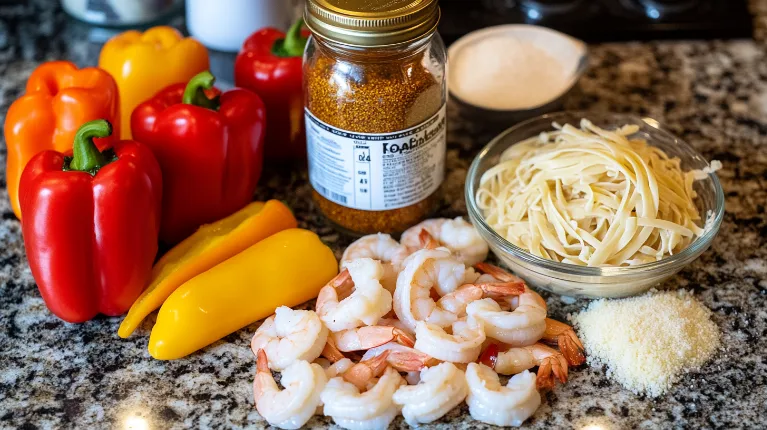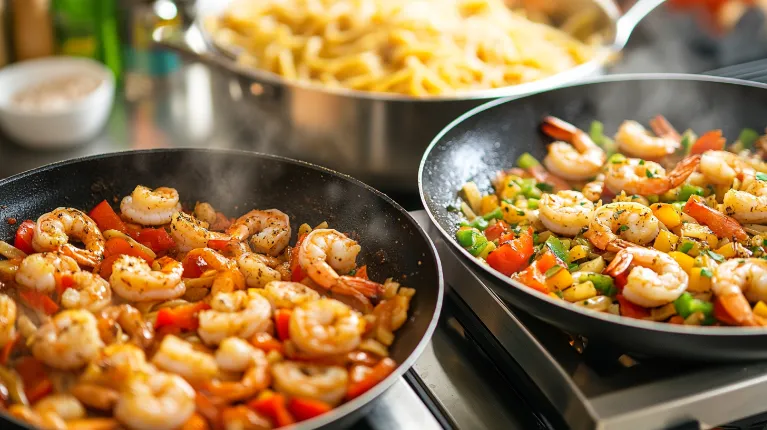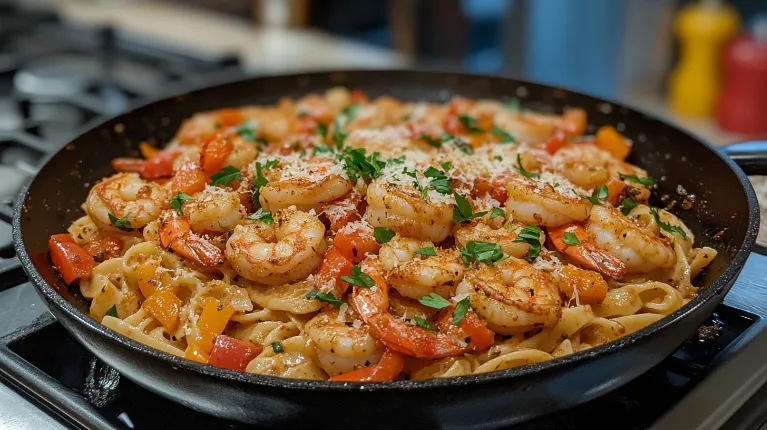Introduction
Let’s be real: there’s something magical about a big bowl of Cajun Shrimp Pasta. It’s that perfect balance of smoky, spicy, and creamy that hits all the right notes. Plus, it’s one of those dishes that feels fancy but is surprisingly easy to whip up. Whether you’re a fan of shrimp or just love bold flavors, this recipe is bound to become your go-to.
Moreover, Cajun Shrimp Pasta isn’t just about taste—it’s also about versatility. You can tweak the heat, swap ingredients to suit your dietary needs, or load it up with veggies for extra goodness. It’s comfort food with a twist, ready in no time and perfect for any occasion.
And you know what’s even better? The roots of this dish are steeped in Louisiana’s rich culinary history, where Cajun and Creole cooking reign supreme. For those curious about the art of seasoning, check out this guide to discover how Cajun spices bring this dish to life.
History and Origin
Cajun Cuisine: A Blend of Tradition and Ingenuity
Cajun cooking comes from the heart of Louisiana, where French-speaking Acadians settled after being expelled from Canada in the 18th century. These resourceful folks made magic with what they had, blending French culinary techniques with local ingredients like crawfish, okra, and peppers. Fast forward to today, and we’ve got a vibrant cuisine that’s equal parts rustic and inventive.
How Cajun Shrimp Pasta Became a Star
You’re probably wondering how pasta joined the party, right? Well, it’s no secret that Italian immigrants brought pasta to America. When Cajun cooks started experimenting, they realized the creamy sauces of their heritage paired perfectly with the bold spices of their new home. Add shrimp, a Louisiana seafood staple, and boom—Cajun Shrimp Pasta was born.
Why It’s So Popular Today
In today’s busy world, folks are always on the hunt for recipes that are both comforting and quick. Cajun Shrimp Pasta ticks both boxes. It’s a one-pan wonder that’s packed with flavor, making it a go-to option for midday lunches or casual get-togethers. Whether it’s the smoky kick from the spices or the luxurious cream sauce, there’s just something about this dish that keeps people coming back for more.
Learn more about the history of Cajun cooking at Wikipedia.
Part 2: Ingredients and Equipment
Ingredients for Cajun Shrimp Pasta
| Ingredient | Quantity | Substitution Options |
|---|---|---|
| Shrimp (peeled and deveined) | 1 lb | Chicken or tofu for a protein alternative. |
| Cajun seasoning | 2 tbsp | Homemade blend or store-bought. |
| Heavy cream | 1 cup | Coconut milk for a dairy-free version. |
| Pasta (fettuccine or linguine) | 12 oz | Gluten-free pasta or zucchini noodles. |
| Garlic (minced) | 3 cloves | Garlic powder in a pinch. |
| Parmesan cheese | ½ cup | Nutritional yeast for a vegan twist. |
| Bell peppers (sliced) | 1 cup | Add mushrooms or zucchini for variety. |
| Olive oil | 2 tbsp | Butter or avocado oil. |
| Onion (chopped) | 1 medium | Shallots for a sweeter flavor. |

Required Equipment
- Large skillet or sauté pan
- Medium pot for boiling pasta
- Mixing bowl for seasoning shrimp
- Tongs for combining pasta and sauce
Stay tuned for Part 3, where we’ll break down the step-by-step process of preparing Cajun Shrimp Pasta!
If you’re a fan of hearty and satisfying lunch recipes like Cajun Shrimp Pasta, you’ll love our Creamy Chicken and Rice Lunch. It’s packed with flavor and perfect for busy weekdays. Or, for something light yet delicious, try our Carrot and Chickpea Salad with Parsley and Lemon—a refreshing option for a quick midday meal.
Step-by-Step Preparation Guide
Mastering the art of Cajun Shrimp Pasta is easier than you think. Follow these detailed steps, and you’ll have a restaurant-quality dish ready in no time.
1. Preparing the Shrimp
Step 1: Clean and Season the Shrimp
First, start with fresh or thawed shrimp. Peel, devein, and pat them dry with a paper towel. Toss the shrimp in a bowl with 2 tablespoons of Cajun seasoning, ensuring each piece is evenly coated. Let the shrimp rest for 5-10 minutes to absorb the spices fully.
Pro Tip: If you’re using frozen shrimp, rinse them under cold water to remove any ice crystals before seasoning.
2. Crafting the Cajun Sauce
Step 2: Sauté the Aromatics
Next, heat 2 tablespoons of olive oil in a large skillet over medium heat. Add the chopped onion and minced garlic, cooking until fragrant and translucent (about 2-3 minutes).
Step 3: Add the Vegetables
Then, toss in the sliced bell peppers. Sauté them for another 3-4 minutes until slightly tender but still crisp. This step enhances the vibrant color and adds a sweet crunch to your Cajun Shrimp Pasta.
Step 4: Create the Sauce Base
Pour 1 cup of heavy cream into the skillet, stirring constantly to avoid scorching. Reduce the heat to low and let the sauce simmer for 3-4 minutes. The cream will thicken slightly, creating a luscious base for the pasta.
Pro Tip: For a dairy-free option, substitute heavy cream with coconut milk. It adds a subtle tropical flavor that complements the Cajun spices.
3. Cooking the Pasta
Step 5: Boil the Pasta
While the sauce simmers, bring a medium pot of salted water to a boil. Add 12 ounces of pasta (fettuccine or linguine works best) and cook according to the package instructions until al dente. Reserve ½ cup of the pasta water before draining.
Step 6: Combine Pasta with Sauce
Transfer the cooked pasta to the skillet with the sauce. Gently toss to coat the noodles evenly. If the sauce seems too thick, add a splash of the reserved pasta water to achieve the desired consistency.
4. Cooking the Shrimp
Step 7: Sear the Shrimp
In a separate skillet, heat 1 tablespoon of olive oil over medium-high heat. Add the seasoned shrimp in a single layer and cook for 2-3 minutes per side, or until they turn pink and opaque. Avoid overcrowding the pan to ensure even cooking.
Pro Tip: Don’t overcook the shrimp—it’s better to slightly undercook them as they’ll continue to cook when mixed with the pasta.
5. Bringing It All Together
Step 8: Combine Shrimp and Pasta
Finally, add the cooked shrimp to the skillet with the pasta and sauce. Toss everything gently to combine, ensuring the shrimp are evenly distributed throughout the dish.
Step 9: Garnish and Serve
Turn off the heat and sprinkle ½ cup of grated Parmesan cheese over the pasta. Top with freshly chopped parsley and a dash of additional Cajun seasoning for extra flavor. Serve hot with a side of garlic bread or a crisp Caesar salad.
Helpful Tips for Success
- Balancing the Spice: If your Cajun Shrimp Pasta turns out too spicy, stir in a splash of cream or a dollop of sour cream to mellow the heat.
- Storage: Store leftovers in an airtight container in the refrigerator for up to 3 days. Reheat gently in a skillet with a splash of water or cream to keep the sauce from drying out.
- Additions and Substitutions: Feel free to add mushrooms, spinach, or even andouille sausage for extra flair.
With these straightforward steps, you’ll have a bowl of Cajun Shrimp Pasta that’s bursting with flavor and ready to impress. It’s perfect for a satisfying lunch, whether you’re enjoying a quiet midday meal, sharing it with colleagues, or prepping for a casual weekend brunch. Stay tuned for the next part, where we explore creative variations and dietary adaptations!

Tips for Perfecting Cajun Shrimp Pasta
Creating the perfect Cajun Shrimp Pasta is straightforward, but a few tips can take it from good to incredible. Here are some helpful pointers to resolve common challenges and enhance your dish.
1. Balancing the Heat
Spice is a hallmark of Cajun Shrimp Pasta, but it’s easy to go overboard. If your dish turns out too spicy, don’t panic. Add a splash of cream or a spoonful of sour cream to tone down the heat. On the other hand, if you prefer a milder dish, start with 1 tablespoon of Cajun seasoning and adjust to taste.
2. Achieving Perfect Shrimp
Overcooked shrimp can ruin the dish’s texture. To avoid this, cook the shrimp just until they turn pink and opaque. Remember, shrimp cook quickly—about 2-3 minutes per side. If you’re worried about timing, undercook them slightly, as they’ll finish cooking when mixed with the hot pasta and sauce.
3. Thickening the Sauce
If the sauce feels too thin, don’t worry! Stir in a cornstarch slurry (1 teaspoon of cornstarch mixed with 1 teaspoon of water) during the simmering process. However, avoid adding too much, as it can make the sauce gloopy. Conversely, if the sauce is too thick, loosen it with a splash of reserved pasta water.
4. Cooking Pasta Perfectly
Cooking the pasta to al dente ensures it holds up in the creamy sauce. Be sure to reserve some pasta water before draining—it’s a handy trick for adjusting the sauce’s consistency later.
Pro Tip: Season your pasta water generously with salt. This simple step makes a huge difference in flavor!
5. Enhancing the Flavor
For an extra kick, add a sprinkle of smoked paprika or a squeeze of fresh lemon juice before serving. These finishing touches brighten the dish and balance its richness.
By keeping these tips in mind, your Cajun Shrimp Pasta will turn out perfectly every time.
Serving and Garnishing Cajun Shrimp Pasta
How you serve Cajun Shrimp Pasta can elevate it from a simple lunch to a gourmet experience. Let’s explore creative presentations and complementary sides perfect for a midday meal.
1. Plating Ideas
Presentation matters, even for comfort food. Use shallow pasta bowls to showcase the creamy sauce and colorful peppers. Garnish with freshly chopped parsley for a pop of green, and sprinkle grated Parmesan or a pinch of Cajun seasoning on top for added flair.
2. Suggested Side Dishes
To complete the meal, pair Cajun Shrimp Pasta with one or more of these sides:
- Garlic Bread: Toasted to perfection, it’s ideal for soaking up the creamy sauce.
- Caesar Salad: A crisp salad with a tangy dressing balances the richness of the pasta.
- Roasted Vegetables: Brussels sprouts, asparagus, or zucchini add a healthy, flavorful contrast.
3. Beverage Pairings
Pairing the right drink enhances the dining experience. A chilled glass of white wine, such as Sauvignon Blanc or Chardonnay, complements the dish’s creamy and spicy notes beautifully. Prefer non-alcoholic options? Try sparkling water with a slice of lemon for a refreshing twist.
With thoughtful garnishing and complementary sides, Cajun Shrimp Pasta transforms into a lunch that’s not only satisfying but also feels like it’s straight out of a gourmet bistro.
Stay tuned for the next section, where we’ll discuss common mistakes to avoid!
Healthier Alternatives and Dietary Considerations
Creating a healthier version of Cajun Shrimp Pasta is easier than you think! With a few thoughtful swaps, you can enjoy this flavorful dish while accommodating various dietary needs.
1. Ingredient Swaps for a Healthier Twist
- Pasta Alternatives:
Replace traditional pasta with whole-grain, gluten-free, or zucchini noodles for a fiber-packed, lower-carb option. - Cream Alternatives:
Instead of heavy cream, use light cream, unsweetened almond milk, or cashew cream for a lighter sauce. These options maintain creaminess without the extra calories. - Shrimp Substitutes:
If you’re not a fan of shrimp or follow a vegetarian diet, substitute with tofu, chickpeas, or mushrooms. They absorb the Cajun seasoning beautifully. - Cheese Options:
Reduce the amount of Parmesan or opt for nutritional yeast for a vegan-friendly alternative that still delivers a cheesy flavor.
2. Meeting Dietary Needs
- For Gluten-Free Diners:
Use gluten-free pasta and double-check that your Cajun seasoning is gluten-free. - For Dairy-Free Diners:
Substitute cream and cheese with plant-based options like coconut milk or vegan cream cheese. - For Low-Sodium Diets:
Make your own Cajun seasoning with reduced salt to control sodium levels.
By making these adjustments, you can tailor Cajun Shrimp Pasta to fit any lifestyle while keeping the dish flavorful and satisfying.
Storing and Reheating Cajun Shrimp Pasta
If you have leftovers, storing and reheating Cajun Shrimp Pasta correctly ensures it tastes just as delicious the next day. Here’s how:
1. Storing Leftovers
- Refrigeration:
- Transfer the pasta to an airtight container.
- Store in the refrigerator for up to 3 days.
- Freezing:
- Place cooled pasta in a freezer-safe container.
- Freeze for up to 2 months.
2. Reheating Tips
- Stovetop:
- Add the pasta to a skillet with a splash of water or cream.
- Heat over low to medium heat, stirring occasionally, until warmed through.
- Microwave:
- Place a single serving in a microwave-safe dish.
- Cover loosely and heat in 30-second intervals, stirring in between.
- Oven:
- Preheat the oven to 350°F.
- Place the pasta in an oven-safe dish, cover with foil, and bake for 15-20 minutes.
3. Pairing Beverages
Pairing the right drink enhances your Cajun Shrimp Pasta experience. For example:
- Wine: A crisp Sauvignon Blanc or lightly oaked Chardonnay complements the creaminess and spice.
- Non-Alcoholic Options: Sparkling water with a splash of lime or iced tea provides a refreshing contrast.
Suggestion: For more creative meal ideas, check out our Easy Lunch Recipes.
With these practical tips, you can store, reheat, and serve your Cajun Shrimp Pasta effortlessly. Coming up next, we’ll address common mistakes to avoid when preparing this flavorful dish!
Frequently Asked Questions about Cajun Shrimp Pasta
The rich flavors and adaptability of Cajun Shrimp Pasta often spark questions from home cooks. Below, we’ve answered some of the most common queries to help you achieve perfect results.
1. Can I Use Frozen Shrimp for Cajun Shrimp Pasta?
Absolutely! Frozen shrimp works wonderfully for Cajun Shrimp Pasta. For example, thaw them under cold running water for a few minutes before seasoning. Consequently, the shrimp will cook evenly and retain their juicy texture.
2. How Can I Make Cajun Shrimp Pasta Less Spicy?
If you prefer a milder dish, reduce the amount of Cajun seasoning or choose a low-sodium version with less heat. Additionally, you can stir in extra cream or a dollop of sour cream to balance the spice.
3. What Are Some Dairy-Free Alternatives for the Sauce?
For a dairy-free version, swap heavy cream with coconut milk or unsweetened almond milk. Nutritional yeast can replace Parmesan, giving your sauce a cheesy flavor without dairy.
4. How Do I Store Leftover Cajun Shrimp Pasta?
Refrigerate leftovers in an airtight container for up to 3 days. If you need to store it longer, freeze it for up to 2 months. To prevent mushy pasta, reheat gently using a stovetop or oven with a splash of water or cream.
5. Can I Add Vegetables to Cajun Shrimp Pasta?
Yes! Vegetables like spinach, mushrooms, or zucchini pair beautifully with the creamy sauce and shrimp. For example, sauté them alongside the peppers for added color and flavor.
Part 9: Conclusion
Cajun Shrimp Pasta is more than just a dish—it’s a flavorful experience that combines bold Cajun spices with creamy comfort. Whether you’re enjoying it as a satisfying midday meal or prepping it ahead for a quick, hassle-free lunch, this recipe is guaranteed to hit the spot.
The versatility of Cajun Shrimp Pasta allows you to customize it to suit your preferences. From adjusting the spice level to adding vegetables or swapping out ingredients for dietary needs, the possibilities are endless.
For example, you can experiment with gluten-free pasta, use dairy-free substitutes, or even swap shrimp for chicken or tofu. These variations make it easy to enjoy this classic dish, no matter your lifestyle or dietary restrictions.
We encourage you to try this recipe and make it your own. Share your results with friends and family, and let us know your favorite twists in the comments. For more exciting meal ideas, don’t forget to explore our Easy Lunch Recipes.
Thank you for joining us on this culinary journey. Now, it’s time to roll up your sleeves and dive into a plate of delicious, creamy Cajun Shrimp Pasta!




